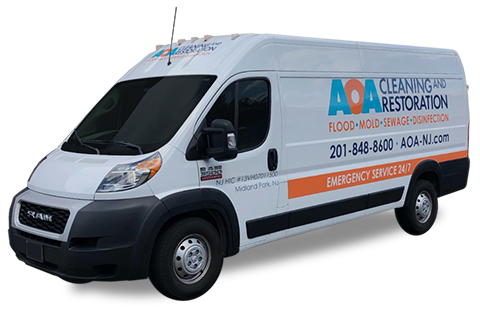It’s hard not to panic when a pipe in your home bursts or a drain backs up. Of course, the very first thing you should do is locate your main water stop valve and turn it off (by turning the small wheel clockwise). This is usually located in your basement near the front foundation wall or inside a crawl space if you have one. It might also be near your water heater.
What’s next? Here are five essential tips for drying out after major water damage:
Extract – The most obvious first step is to call a company like AOA Cleaning & Restoration to extract as much of the water as possible. We use professional-grade vacuums and pumps to remove excess water from floors, furniture, and carpets. If you’re doing things yourself, once most of the water is removed with a wet vacuum, a portable extraction unit (which you should be able to rent at a local hardware store) can also help.
Remove – It’s critical to remove wet carpet and furniture when mitigating an area. Some carpet can be dried and saved, but if your flood was caused by a sewer backup, it will need to be thrown away. Either way, this is usually a hefty job and best saved for the professionals.
Evaporate – Wood framing, subfloors, and drywall become saturated with water during a flood, so it’s important to dry them out fast to minimize the growth of bacteria and mold. Commercially available fans are helpful, but professionals typically use industrial air movers, which are much more powerful and help speed the evaporation process along exponentially. We generally use one of these industrial air movers for every 10 feet of wall space.
Dehumidify – The evaporation process increases humidity levels, so it’s important to remove any air moisture. Industrial dehumidifiers are best because they work fast and are more powerful. If you live in a dry climate where the humidity outside is lower than the inside, opening doors and windows is great—but be sure to close them if the outside humidity rises.
Heat – Warm air helps dry things more quickly, so as long as your furnace and air conditioning units were not flooded (which can cause contamination), you can turn on the heat to increase the drying rate. However, keep in mind that warm air will hold more moisture so once you’ve reached a temperature (like 80 degrees), turn the air conditioner on to cool the house again. This process can be repeated until the home is dry.
Of course, drying out is only part of the battle when you’re dealing with the aftermath of a flood. It’s also important to disinfect the area properly to prevent the growth of mold and remove any harmful biological contaminants and microbes. This is something AOA Cleaning & Restoration can help with, of course. We use industrial-strength disinfectants and equipment to ensure every home or property we clean after a flood or sewage backup is restored to its original condition.
If you need help drying out your home after a flood, call us at 201-848-5900. Our trained, certified cleaning and restoration professionals provide 24/7 emergency service and will help get your home back to normal as fast as possible.




















